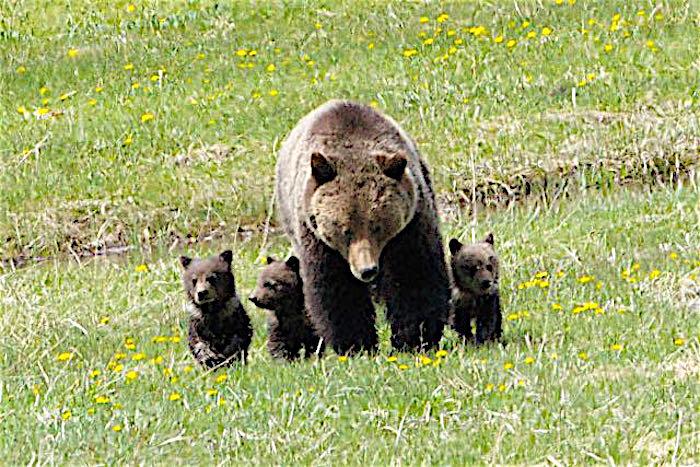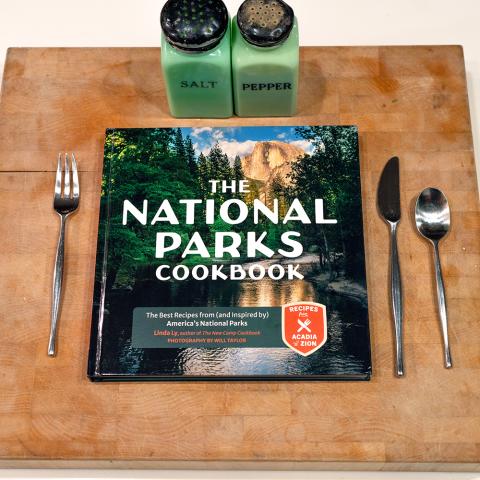
Park Service doesn't want a hunting free-for-all if grizzlies are delisted/Randy Bjerke
National Park Service officials are supportive of plans to remove grizzly bears from Endangered Species list protections, but with a number of caveats. Among them are requests that the delisting plan both limits the chance that wounded bears venture back into parks and reduces the likelihood that "well-known or transboundary bears" are killed by hunters.
Bears, of course, don't know when they might leave Yellowstone or Grand Teton national parks and wander into one of the surrounding national forests. But if the U.S. Fish and Wildlife Service succeeds with its plans to remove grizzly bears, aka Ol' Ephraim, aka Ursus arctos horribilis, from ESA protection, officials in Wyoming, Idaho, and Montana plan to be ready with hunting regulations for that day. And that could put any grizzly that leaves either of those parks in the crosshairs of a hunting rifle.
"The NPS continues to focus on supporting the delisting process while trying to ensure values of the NPS are considered in management strategies and actions. Grizzly bears are a premier wildlife attraction for visitors to Yellowstone, Grand Teton and John D. Rockefeller, Jr., Memorial Parkway; and those visitors bring tens of millions of dollars into the regional economy," wrote Sue Masica, (letter attached below) who oversees the Park Service's Intermountain Region, in the agency's official comments to the delisting proposal. "The bears contribute to the public's enjoyment and sense of pride in our conservation heritage."
To see that those values aren't overturned, the Park Service asks that "future grizzly bear harvests within the Greater Yellowstone Ecosystem be conducted in a manner that: I) respects the NPS mission; 2) protects regional economic benefits and the enjoyment of bear watching; 3) reduces the risks associated with wounded bears entering NPS units; and 4) limits the likelihood that well-known or transboundary bears will be harvested."
Along those lines, Regional Director Masica specifically asked that the Rockefeller parkway officially be recognized as one of the three park units that could be impacted by the delisting decision and that it, as with Yellowstone and Grand Teton, be off-limits to hunters.
Biologically, the Park Service has asked the Fish and Wildlife Service to perform an analysis into how hunting impacts might affect the potential for connectivity between the GYE grizzly populations and those in the Northern Continental Divide Ecosystem that includes Glacier National Park in northern Montana. Additionally, the agency requested that if the grizzly population in the GYE falls below 600 individuals that hunting be stopped.
While the Fish and Wildlife Service intends to complete the delisting process by year's end, it likely won't go smoothly. Wyoming officials maintain that the enabling legislation for the John D. Rockefeller, Jr., Memorial Parkway allows hunting there, and so grizzlies that wander into the parkway would be fair game.
“My understanding is they can’t change that," Brian Nesvik, Wyoming Game and Fish Department chief game warden, told WyoFile last week.
Just the same, he added, Wyoming didn't push for wolf hunting in the parkway when that species was delisted, and so it is too early to say whether the state would try to open the parkway to grizzly hunts.
Lawsuits also could be in the mix. Like Yellowstone's wolves and bison, the park's grizzlies, and those in neighboring Grand Teton, are iconic and widely admired. The prospect of them ending up as trophy animals isn't easily accepted among those groups. That was evident in the uproar spurred by the recent news that Scarface, an iconic Yellowstone grizzly, had been killed by a hunter just north of the park's borders.
Too, there's the question some groups have voiced about whether the GYE grizzlies can survive hunting seasons.
"The historic comeback of the Yellowstone grizzly bear population is truly a remarkable achievement. But the current proposal threatens progress made to date. The Service is rushing to delist the grizzly bear before it knows how the Northern Rockies states and other federal agencies plan to manage it. It is unacceptable to proceed with delisting when the state and federal plans governing how this population will be managed are incomplete and therefore, unenforceable," said Jamie Rappaport Clark, president and CEO of Defenders of Wildlife and a former FWS director.
“Further, the Service’s current proposal doesn’t provide grizzlies with enough protections to ensure their long-term recovery. We can’t afford to be careless with this species. There is no need to rush this process, but that’s exactly what the Service appears to be doing.”




 Support Essential Coverage of Essential Places
Support Essential Coverage of Essential Places







Comments
Yes - beneficial effects:
Grazing offers a bounty of benefits
Ranchers and researchers say there are a number of very important environmental benefits from responsible grazing of public and private lands. Those benefits include:
Increased diversity of plant and animal species.
Control of invasive plant species, such as yellow starthistle.
Habitat restoration for threatened and endangered species.
Controlling erosion from water runoff for improved water quality.
Improving vegetation along stream banks and watershed health.
Reducing wildfire threat from rangeland fires.
Offering visually attractive vistas.
Preventing fragmentation of habitat from housing and commercial development and maintaining connected wildlife corridors.
Preserving open space in a rapidly growing state.
Providing food for consumers.
Offering recreational opportunities, such as hiking and wildlife viewing.
http://californiabountiful.com/features/article.aspx?arID=561
Livestock grazing can result in impacts on public land resources, but well-managed grazing provides numerous environmental benefits as well. For example, while livestock grazing can lead to increases in some invasive species, well-managed grazing can be used to manage vegetation. Intensively managed "targeted" grazing can control some invasive plant species or reduce the fuels that contribute to severe wildfires. Besides providing such traditional products as meat and fiber, well-managed rangelands and other private ranch lands support healthy watersheds, carbon sequestration, recreational opportunities, and wildlife habitat. Livestock grazing on public lands helps maintain the private ranches that, in turn, preserve the open spaces that have helped write the West's history and will continue to shape this region's character in the years to come.
http://www.blm.gov/wo/st/en/prog/grazing.html
Are you serious, or this was a bad joke?
Ah, Esteemed Comrade, look at the contradictions in your post above. It looks like Fernando spotted them.
You repeatedly use the words "well managed grazing." Show me a rancher who manages his rangelands well and I'll show you a very rare individual --- at least in the desert southwest.
Several are simply bogus:
Increased diversity of plant and animal species.
Control of invasive plant species, such as yellow starthistle.
Habitat restoration for threatened and endangered species.
Controlling erosion from water runoff for improved water quality.
Improving vegetation along stream banks and watershed health.
Every one of the items in this list are serious environmental THREATS. Not by any stretch of the imagingation are they benefits in any but a very unusual circumstance.
Fernando is right. It has to be a bad joke. I guess we now need to let other readers make up their own minds.
I will take the word of the BLM over your baseless rants.
An d I'll simply take it that you know a good bit about bovine end product.
CaliforniaFarm Bureau?
And how many other times have you decried the unreliablity of various government agencies on these very web pages?
How much personal experience do you have working with cattle or sheep? In Utah, the main source of polluants in streams such as the Bear River is --- ready for this --- animal waste from ranches.
Note too, that the piece from BLM speaks in terms of "responsible management" and also states that it's the GOAL of BLM management. However, if you talk to most any BLM range managers, they will tell you that the agency falls far short of those goals in most cases. Of course, the opinions of those doing the work on the ground may be quite different from those at higher levels in the agency where political pressures demand toeing an official story for public consumption. Kinda like the disconnect between what we hear talking with field rangers and WASO types in the NPS.
Nope, I'm afraid Fernando is still right.